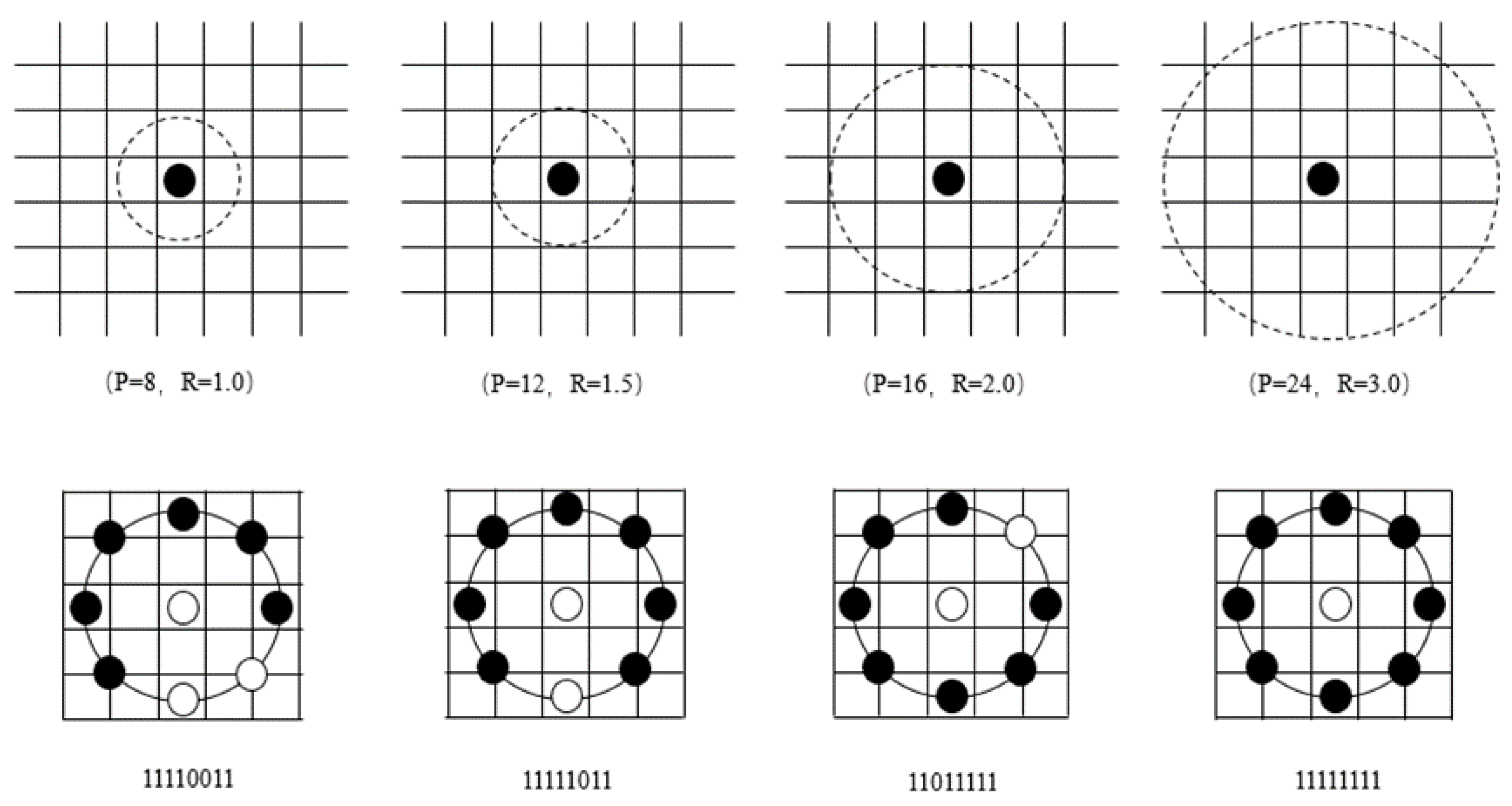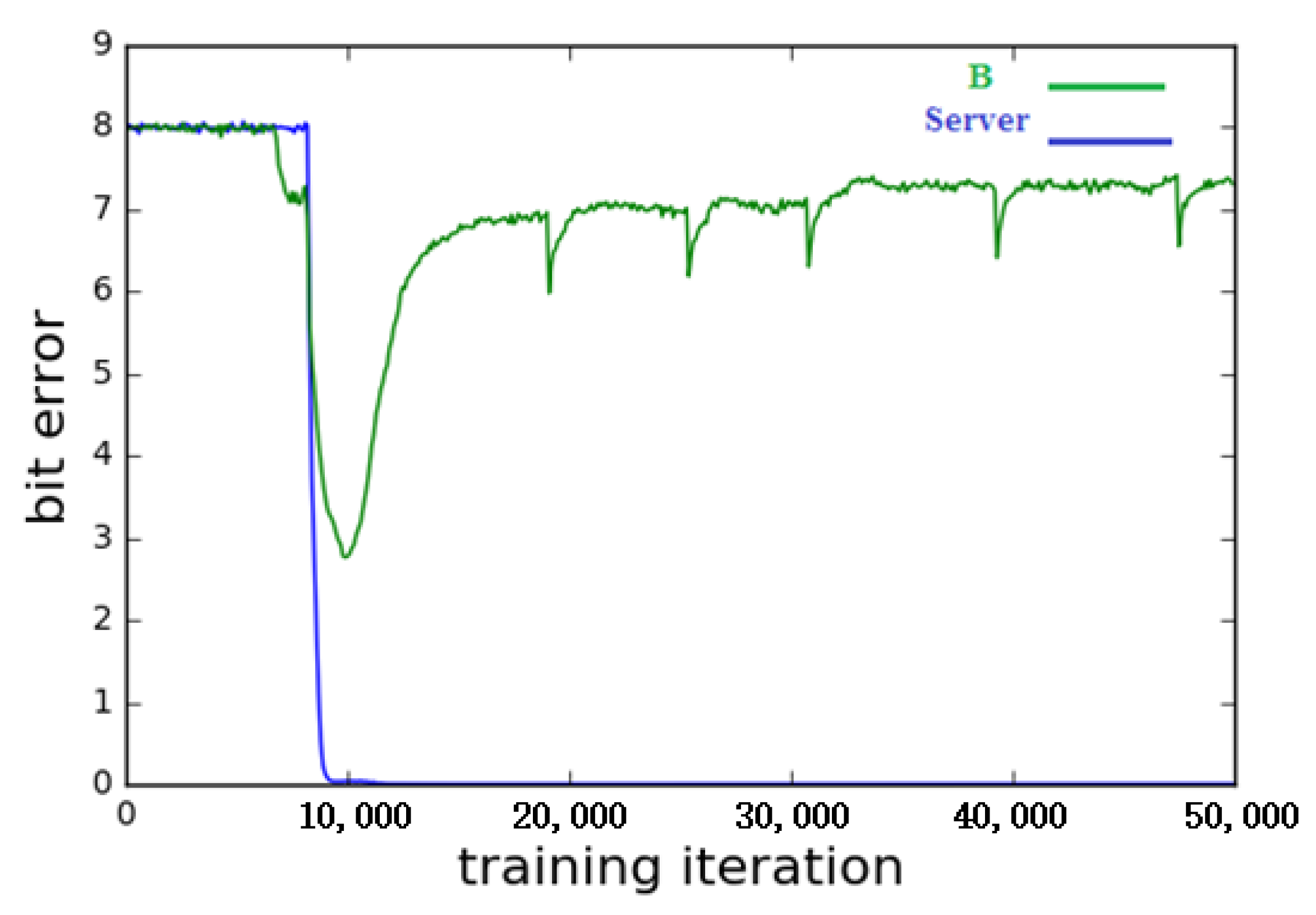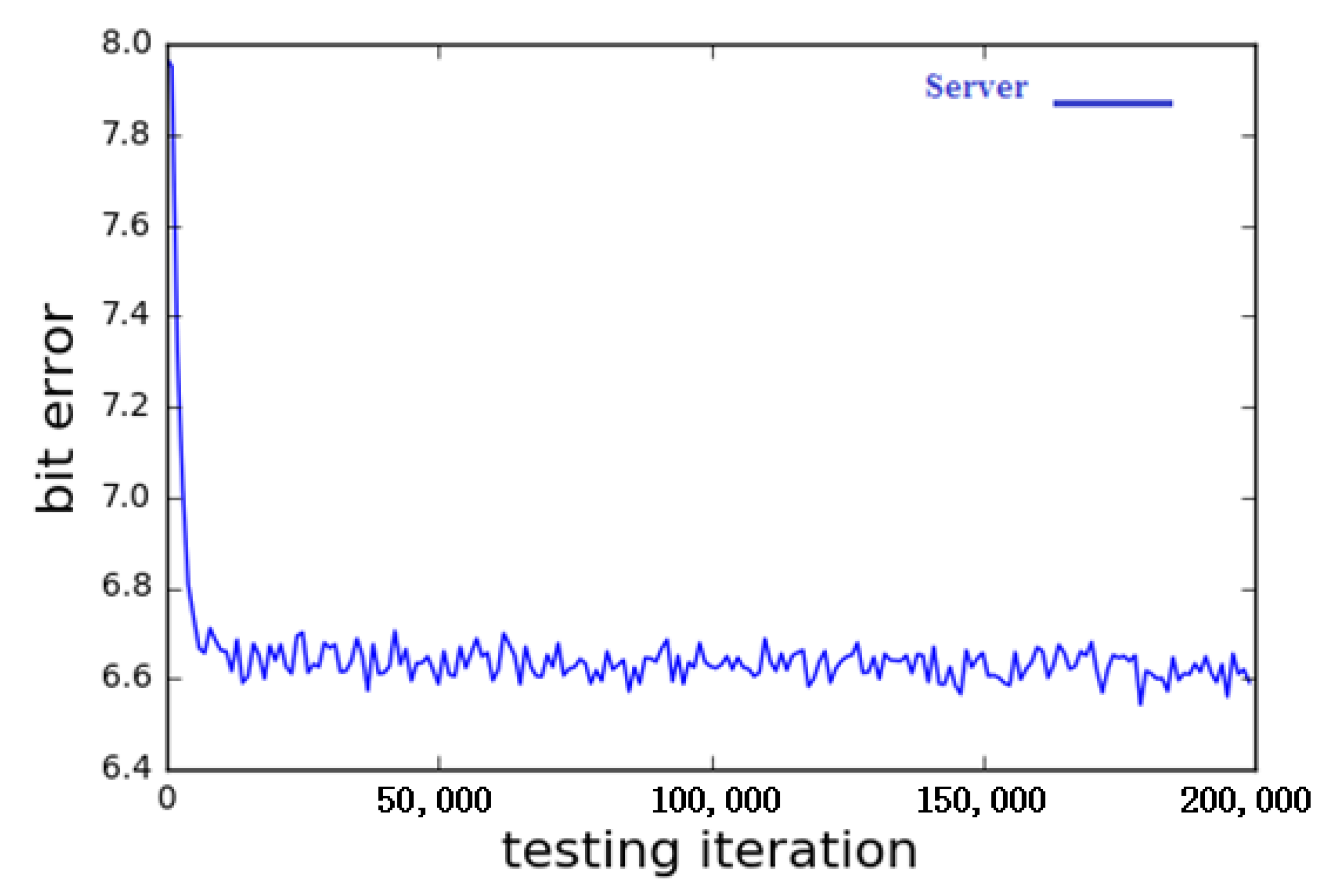WGAN-E: A Generative Adversarial Networks for Facial Feature Security
Abstract
1. Introduction
2. Related Work
3. Face Feature Description and Neural Network Encryption Model
3.1. Face Feature Description
3.2. Principles of Encryption and Decryption
3.3. WGAN-E Encrypts Facial Feature Data
| Algorithm 1 WGAN-E, a neural cryptography algorithm. All experiments in the study used default values α = 0.001, c = 0.04, m = 2000, = 25, λ = 10, β1 = 0, β2 = 0.9. |
| Require:c, the clipping parameter. m, the batch size. , hyperparameters parameters. , the number of iterations of the critic per generator iteration. The gradient penalty coefficient λ, Adam hyperparameters α (the learning rate). , initial critic parameters. , initial generator’s parameters. x, face image data vectors. z, face LBP data vector. 1: while has not converged do 2: for do 3: for do 4: Sample a batch from the real data. 5: Sample a batch of prior samples. 6: a random number . 7: 8: 9: 10: 11: 12: 13: end for 14: 15: end for 16: Sample a batch of prior samples. 17: 18: 19: 20: end while |
3.4. WGAN-E Neural Network Structure
4. Experiment and Analysis of Results
4.1. Data Preprocessing
4.2. Experimental Process
4.3. Analysis of Experimental Results
5. Conclusions and Future Work
Author Contributions
Funding
Acknowledgments
Conflicts of Interest
References
- Ahonen, T.; Hadid, A.; Pietikäinen, M. Face Recognition with Local Binary Patterns. In Proceedings of the Advances in Visual Computing; Springer Science and Business Media LLC: Berlin, Germany, 2004; Volume 3021, pp. 469–481. [Google Scholar]
- Ren, S.; He, K.; Girshick, R.; Sun, J. Faster R-CNN: Towards Real-Time Object Detection with Region Proposal Networks. IEEE Trans. Pattern Anal. Mach. Intell. 2017, 39, 1137–1149. [Google Scholar] [CrossRef]
- Jiang, H.; Learned-Miller, E. Face Detection with the Faster R-CNN. In Proceedings of the 2017 12th IEEE International Conference on Automatic Face & Gesture Recognition (FG 2017), Washington, DC, USA, 30 May–3 June 2017; pp. 650–657. [Google Scholar]
- Dayan, P.; Hinton, G.E.; Neal, R.M.; Zemel, R.S. The Helmholtz Machine. Neural Comput. 1995, 7, 889–904. [Google Scholar] [CrossRef] [PubMed]
- Wu, S.; Kan, M.; He, Z.; Shan, S.; Chen, X. Funnel-structured cascade for multi-view face detection with alignment-awareness. Neurocomputing 2017, 221, 138–145. [Google Scholar] [CrossRef]
- Cavoukian, A.; Marinelli, T.; Stoianov, A.; Martin, K.; Plataniotis, K.N.; Chibba, M.; DeSouza, L.; Frederiksen, S. Biometric Encryption: Creating a Privacy-Preserving ‘Watch-List’ Facial Recognition System. In Security and Privacy in Biometrics; Springer Science and Business Media LLC: London, Britain, 2013; pp. 215–238. [Google Scholar]
- Goldwasser, S.; Micali, S. Probabilistic encryption. J. Comput. Syst. Sci. 1984, 28, 270–299. [Google Scholar] [CrossRef]
- Guo, D.H. ASIC Design of Chaotic Encryption Based on Neural Networks. Chin. J. Comput. 2000. [Google Scholar]
- Lumini, A.; Nanni, L. An improved BioHashing for human authentication. Pattern Recognit. 2007, 40, 1057–1065. [Google Scholar] [CrossRef]
- Teoh, A.B.; Ngo, D.C. Biophasor: Token Supplemented Cancellable Biometrics. In Proceedings of the 2006 9th International Conference on Control, Automation, Robotics and Vision, Singapore, 5–8 December 2006; Institute of Electrical and Electronics Engineers (IEEE); pp. 1–5. [Google Scholar]
- Sutcu, Y.Q.; Memon, N. Secure Sketch for Biometric Templates. Comput. Vis. 2006, 4284, 99–113. [Google Scholar]
- Hong-Yu, L.I. A Stream Cipher Encryption Method Based on Neural Network. Sci. Technol. Inf. 2008. [Google Scholar]
- Jiang, L.; Shanghai, L. A multistage chaotic encryption algorithm based on neural network. Comput. Appl. Softw. 2006. [Google Scholar]
- Yi, L.I.; Pan, X.J. AES Based on Neural Network of Chaotic Encryption Algorithm. Sci. Technol. Eng. 2010. [Google Scholar]
- He, C.; Ming, K.; Wang, Y.; Wang, Z.J. A Deep Learning Based Attack for The Chaos-based Image Encryption. arXiv 2019, arXiv:1907.12245. [Google Scholar]
- Fei, H.; Pu, C.; Gao, H.; Tang, M.; Li, L. An image compression and encryption scheme based on deep learning. arXiv 2016, arXiv:1608.05001. [Google Scholar]
- Xie, P.; Wu, B.; Sun, G. BAYHENN: Combining Bayesian Deep Learning and Homomorphic Encryption for Secure DNN Inference. arXiv 2019, arXiv:1906.00639. [Google Scholar]
- Ryffel, T.; Trask, A.; Dahl, M.; Wagner, B.; Mancuso, J.; Rueckert, D.; Passerat-Palmbach, J. A generic framework for privacy preserving deep learning. arXiv 2018, arXiv:1811.04017v2. [Google Scholar]
- Alon, B.; Oren, E.; Ran, G.-B. Low Latency Privacy Preserving Inference. arXiv 2018, arXiv:1812.10659. [Google Scholar]
- Le, T.P.; Aono, Y.; Hayashi, T.; Wang, L.; Moriai, S. Privacy-Preserving Deep Learning via Additively Homomorphic Encryption. IEEE Trans. Inf. Forensics Secur. 2018, 13, 1333–1345. [Google Scholar]
- Lotfollahi, M.; Siavoshani, M.J.; Zade, R.S.H.; Saberian, M. Deep packet: A novel approach for encrypted traffic classification using deep learning. Soft Comput. 2019, 24, 1999–2012. [Google Scholar] [CrossRef]
- Coutinho, M.; Albuquerque, R.D.O.; Borges, F.; Villalba, L.J.G.; Kim, T.-H. Learning Perfectly Secure Cryptography to Protect Communications with Adversarial Neural Cryptography. Sensors 2018, 18, 1306. [Google Scholar] [CrossRef]
- Li, J.; Yang, Y.; Ge, H.; Wang, Y.; Zhao, L. Generative adversarial nets in laser-induced fluorescence spectrum image recognition of mine water inrush. Int. J. Distrib. Sens. Networks 2019, 15. [Google Scholar] [CrossRef]
- Kinzel, W.; Kanter, I. Neural Cryptography; Institute of Electrical and Electronics Engineers (IEEE): New York, NY, USA, 2004; pp. 1351–1354. [Google Scholar]
- Gulrajani, I.; Ahmed, F.; Arjovsky, M.; Dumoulin, V.; Courville, A. Improved Training of Wasserstein GANs. arXiv 2017, arXiv:1704.00028v3. [Google Scholar]
- Denton, E.; Chintala, S.; Szlam, A.; Fergus, R. Deep Generative Image Models using a Laplacian Pyramid of Adversarial Networks. arXiv 2015. [Google Scholar]
- Arjovsky, M.; Chintala, S.; Bottou, L. Wasserstein GAN. arXiv 2017, arXiv:1701.07875v2. [Google Scholar]
- Rouhani, B.D.; Riazi, M.S.; Koushanfar, F. DeepSecure: Scalable Provably-Secure Deep Learning. arXiv 2018, arXiv:1705.08963. [Google Scholar]
- Xie, P.; Bilenko, M.; Finley, T.; Gilad-Bachrach, R.; Lauter, K.; Naehrig, M. Crypto-Nets: Neural Networks over Encrypted Data. Comput. Sci. 2014. [Google Scholar]
- Ke, Y.; Zhang, M.; Liu, J.; Su, T. Generative Steganography with Kerckhoffs’ Principle based on Generative Adversarial Networks. arXiv 2017, arXiv:1711.04916. [Google Scholar]
- Kingma, D.; Ba, J. Adam: A Method for Stochastic Optimization. Comput. Sci. 2014. [Google Scholar]
- Barone, A.V.M. Low-rank passthrough neural networks. In Proceedings of the Workshop on Deep Learning Approaches for Low-Resource NLP, Melbourne, Australia; 2018. [Google Scholar]
- Lahiri, A.; Jain, A.; Nadendla, D.; Biswas, P.K. Improved Techniques for GAN based Facial Inpainting. arXiv 2018, arXiv:1810.08774. [Google Scholar]
- Boemer, F.; Costache, A.; Cammarota, R.; Wierzynski, C. nGraph-HE2: A High-Throughput Framework for Neural Network Inference on Encrypted Data. In Proceedings of the 7th ACM Workshop on Encrypted Computing & Applied Homomorphic Cryptography, London, UK, 11–15 November 2019. [Google Scholar]
- Nowozin, S.; Cseke, B.; Tomioka, R. f-GAN: Training Generative Neural Samplers using Variational Divergence Minimization. In Proceedings of the Advances in Neural Information Processing Systems, Barcelona, Spain, 5–10 December 2016. [Google Scholar]
- Shaon, F.; Kantarcioglu, M.; Ranise, S.; Swarup, V. A Practical Framework for Executing Complex Queries over Encrypted Multimedia Data. In Proceedings of the Advances in Visual Computing; Springer Science and Business Media LLC: Cham, Germany, 2016; Volume 9766, pp. 179–195. [Google Scholar]









| MD5 | SHA1 | HMAC | AES | DES | RSA | ECC | WGAN | |
|---|---|---|---|---|---|---|---|---|
| LBP | M | H | L | H | L | H | H | H |
| Gabor | L | M | L | M | L | M | H | H |
| ASM | L | M | M | H | M | H | H | H |
| SeetaFace | M | H | L | H | L | H | H | H |
| FaceNet | H | H | M | H | M | H | H | H |
| OpenFace | M | H | L | H | L | H | H | H |
| MD5 | SHA1 | HMAC | AES | DES | RSA | ECC | WGAN | |
|---|---|---|---|---|---|---|---|---|
| LBP | M | H | L | H | L | M | M | H |
| Gabor | M | H | L | H | L | M | M | H |
| ASM | M | H | L | H | L | M | M | H |
| SeetaFace | M | H | L | H | L | M | M | H |
| FaceNet | M | H | L | H | L | M | M | H |
| OpenFace | M | H | L | H | L | M | M | H |
| MD5 | SHA1 | HMAC | AES | DES | RSA | ECC | WGAN | |
|---|---|---|---|---|---|---|---|---|
| LBP | L | H | M | H | M | M | H | H |
| Gabor | L | M | M | H | M | M | M | H |
| ASM | L | H | L | H | L | M | H | M |
| SeetaFace | L | H | M | H | M | M | H | H |
| FaceNet | L | H | M | H | M | M | H | H |
| OpenFace | L | H | M | H | M | M | H | H |
| MD5 | SHA1 | HMAC | AES | DES | RSA | ECC | WGAN | |
|---|---|---|---|---|---|---|---|---|
| LBP | FR | S | M | FR | F | M | S | F |
| Gabor | FR | M | F | FR | F | M | S | F |
| ASM | FR | M | F | FR | M | F | S | F |
| SeetaFace | F | S | M | F | F | S | S | M |
| FaceNet | F | S | S | F | FR | S | S | M |
| OpenFace | M | S | M | F | F | M | S | M |
| MD5 | SHA1 | HMAC | AES | DES | RSA | ECC | WGAN | |
|---|---|---|---|---|---|---|---|---|
| LBP | M | H | L | H | L | H | H | H |
| Gabor | M | H | L | H | L | H | H | H |
| ASM | M | H | L | H | L | H | H | H |
| SeetaFace | M | H | L | H | L | H | H | H |
| FaceNet | M | H | L | H | L | H | H | H |
| OpenFace | M | H | L | H | L | H | H | H |
| BioHashing | BioPhasor | SecureSketch | WGAN-E | |
|---|---|---|---|---|
| LBP | 0.02 | 0 | 0 | 0 |
| Gabor | 0.01 | 0.02 | 0 | 0 |
| ASM | 0 | 0.01 | 0.01 | 0 |
| SeetaFace | 0 | 0 | 0 | 0 |
| FaceNet | 0 | 0 | 0.01 | 0 |
| OpenFace | 0.01 | 0 | 0 | 0 |
| BioHashing | BioPhasor | SecureSketch | WGAN-E | |
|---|---|---|---|---|
| LBP | 0.71 | 0.85 | 0.80 | 0.56 |
| Gabor | 0.72 | 0.82 | 0.82 | 0.58 |
| ASM | 0.71 | 0.86 | 0.82 | 0.58 |
| SeetaFace | 0.70 | 0.81 | 0.77 | 0.52 |
| FaceNet | 0.70 | 0.82 | 0.78 | 0.53 |
| OpenFace | 0.70 | 0.81 | 0.77 | 0.53 |
© 2020 by the authors. Licensee MDPI, Basel, Switzerland. This article is an open access article distributed under the terms and conditions of the Creative Commons Attribution (CC BY) license (http://creativecommons.org/licenses/by/4.0/).
Share and Cite
Wu, C.; Ju, B.; Wu, Y.; Xiong, N.N.; Zhang, S. WGAN-E: A Generative Adversarial Networks for Facial Feature Security. Electronics 2020, 9, 486. https://doi.org/10.3390/electronics9030486
Wu C, Ju B, Wu Y, Xiong NN, Zhang S. WGAN-E: A Generative Adversarial Networks for Facial Feature Security. Electronics. 2020; 9(3):486. https://doi.org/10.3390/electronics9030486
Chicago/Turabian StyleWu, Chunxue, Bobo Ju, Yan Wu, Neal N. Xiong, and Sheng Zhang. 2020. "WGAN-E: A Generative Adversarial Networks for Facial Feature Security" Electronics 9, no. 3: 486. https://doi.org/10.3390/electronics9030486
APA StyleWu, C., Ju, B., Wu, Y., Xiong, N. N., & Zhang, S. (2020). WGAN-E: A Generative Adversarial Networks for Facial Feature Security. Electronics, 9(3), 486. https://doi.org/10.3390/electronics9030486






